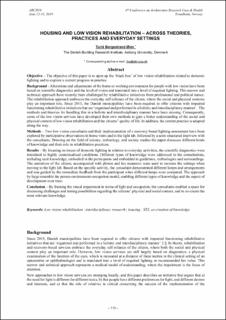| dc.contributor.author | Øien, Turid Borgestrand | |
| dc.date.accessioned | 2021-12-27T18:41:38Z | |
| dc.date.available | 2021-12-27T18:41:38Z | |
| dc.date.issued | 2021 | |
| dc.identifier.isbn | 978-82-536-1718-3 | |
| dc.identifier.issn | 2387-4295 | |
| dc.identifier.uri | https://hdl.handle.net/11250/2835488 | |
| dc.description.abstract | Objective – The objective of this paper is to open up the ‘black box’ of low vision rehabilitation related to domestic lighting and to explore a current progress in practice.
Background - Alterations and adjustments of the home or working environment for people with low vision have been based on scientific diagnostics and the level of vision and translated into a level of required lighting. This narrow and technical approach have recently been challenged by rehabilitative initiatives from professional and political stance. The rehabilitation approach embraces the everyday self-reliance of the citizen, where the social and physical contexts play an important role. Since 2015, the Danish municipalities have been required to offer citizens with impaired functioning rehabilitative initiatives that are ‘organised and performed in a holistic and interdisciplinary manner’. The methods and theories for handling this in a holistic and interdisciplinary manner have been missing. Consequently, some of the low vision services have developed their own methods to gain a better understanding of the social and physical context of low vision rehabilitation and the citizens’ quality of life. In addition, the current practice is adapted along the way.
Methods – Two low vision consultants and their implementation of a recovery-based lighting assessment have been explored by participative observations in home visits and in the light lab, followed by a semi structured interview with the consultants. Drawing on the field of science, technology, and society studies the paper discusses different kinds of knowledge and their role in rehabilitation practices.
Results – By focusing on issues of domestic lighting in relation to everyday activities, the scientific diagnostics were translated to highly contextualised conditions. Different types of knowledge were addressed in the consultations, including tacit knowledge, embodied in the participants and embedded in guidelines, technologies and surroundings. The narratives of the citizen, accompanied with photos and lux measures were used to recreate the settings when moving to the light lab. Based on the specific activity, the consultant demonstrated different lamps and arrangements and was guided by the immediate feedback from the participant when different lamps were compared. The approach by large resemble the person-environment-occupation model, enabling different types of knowledge and the aspect of development over time.
Conclusion – By framing the visual impairment in terms of light and occupation, the consultants enabled a space for discussing challenges and testing possibilities regarding the citizens’ physical and social context, and to co-create the most relevant knowledge. | |
| dc.language.iso | eng | |
| dc.publisher | SINTEF Academic Press | |
| dc.relation.ispartof | ARCH19 June 12–13, 2019 – Trondheim, Norway. Proceedings from the 4th Conference on Architecture Research Care & Health | |
| dc.relation.ispartofseries | SINTEF Proceedings;8 | |
| dc.rights | CC BY 4.0 | |
| dc.rights.uri | https://creativecommons.org/licenses/by/4.0/ | |
| dc.subject | Low vision rehabilitation | |
| dc.subject | Interdisciplinary research Housing | |
| dc.subject | STS, co-creation of knowledge | |
| dc.title | Housing and Low Vision Rehabilitation – Across Theories, Practices and Everyday Settings | |
| dc.type | Chapter | |
| dc.type | Peer reviewed | |
| dc.type | Conference object | |
| dc.description.version | publishedVersion | |
| dc.rights.holder | © 2021 The Authors. | |
| dc.subject.nsi | VDP::Medisinske Fag: 700::Helsefag: 800 | |

